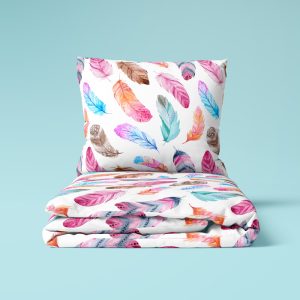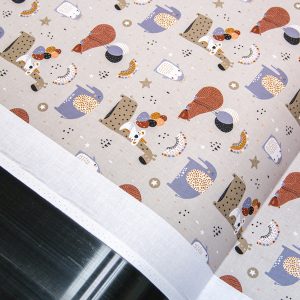Curtains are not just a practical element of interior design but also a vital decorative feature that influences the atmosphere and style of a room. Choosing the right fabric for curtains can completely transform the look of an interior, lending it elegance, coziness, or a modern touch. In this article, we’ll explore the best fabrics for curtains, their properties, and applications to help you make the right choice.
Table of Content
- Why Is Choosing the Right Curtain Fabric So Important?
- Natural Fabrics
- Cotton – Versatile and Easy to Care For
- Linen – Airy and Sophisticated
- Synthetic Fabrics and Blends
- Velvet for a Luxurious Look
- How to choose a fabric for the style and function of the room to create a cohesive and functional interior design?
- Summary – how to choose the best material for curtains?
Why Is Choosing the Right Curtain Fabric So Important?
Choosing the right material for curtains has a huge impact on the appearance and functionality of an interior. Curtain fabrics for interior design influence the atmosphere of the room, its lighting, and acoustics. Parameters worth considering include weight, light transmission, and ease of care. Curtain fabrics for window decoration should be matched to the style and function of the room.
Appropriately selected curtains can visually enlarge or reduce a room, add warmth or coolness, and provide privacy and protection from excessive sunlight. Therefore, it is worth taking the time to choose the perfect curtain fabric that meets all your expectations.
Natural Fabrics
Cotton – Versatile and Easy to Care For
Curtain fabrics made of cotton are versatile and suit various interiors. Cotton linen fabrics for curtains are natural, breathable, and easy to care for. They work well in the living room, bedroom, or kitchen.
Characteristics:
- Natural fiber, hypoallergenic
- Soft and pleasant to the touch
- Available in many patterns and colors
Pros:
- Naturalness and breathability: Cotton is a natural material that allows the skin to breathe, which is especially important in rooms where we spend a lot of time.
- Ease of care: Cotton curtains can be machine washed, making them easy to keep clean.
- Variety of patterns and colors: Cotton is available in a wide range of patterns and colors, allowing you to match the curtains to any interior style.
- Versatility: Cotton curtains suit various rooms, from the living room to the kitchen.
Cons:
- May wrinkle: Cotton tends to wrinkle, which may require frequent ironing (classic crisp cotton can help minimize this).
- May fade in sunlight: Some types of cotton may lose color under intense sunlight.
- May shrink after washing: Cotton may shrink after washing, so it is important to follow the manufacturer’s care instructions.
- Less stain-resistant: Cotton is less stain-resistant than synthetic fabrics.
Linen – Airy and Sophisticated
Curtain fabrics made of linen are valued for their elegance and natural look. Linen fabric is particularly popular in Scandinavian and boho-style interiors. Linen curtain fabric adds lightness and natural charm to interiors (sheer linens enhance this).
Characteristics:
- Natural, thick fiber
- Matte, slightly rough texture
- Subdued, natural colors
Visual Effects:
- Natural texture
- Lightness and breathability
- Subdued, natural colors
Pros:
- Durability and strength: Linen is a very durable and strong material that will last for many years.
- Antiallergic properties: Linen is naturally antiallergic, making it an ideal choice for allergy sufferers.
- Natural, elegant appearance: Linen has a natural, elegant look that adds charm to interiors (classic linen mix offers versatility).
- Good air permeability: Linen provides good air circulation in the room.
Cons:
- Wrinkles easily: Linen tends to wrinkle easily, which may require frequent ironing.
- May shrink after washing: Linen may shrink after washing, so it is important to follow the manufacturer’s care instructions.
- Higher price: Linen fabric is usually more expensive than cotton or synthetic fabrics.
- Limited color palette: Linen is available in a limited palette of colors, mainly in natural shades.

Synthetic Fabrics and Blends
Curtain fabrics made of polyester and synthetic blends are durable and easy to care for. They are worth considering when practicality and stain resistance are important.
Characteristics:
- Durable and wrinkle-resistant
- Easy to care for (machine washable)
- Wide selection of colors and patterns
Advantages:
- Durability and wrinkle resistance: Polyester and synthetic blends are very durable and wrinkle-resistant, making it easy to keep curtains in good condition.
- Ease of care: Curtains made of polyester and synthetic blends can be machine washed, making them easy to clean.
- Wide selection of colors and patterns: Polyester and synthetic blends are available in a wide range of colors and patterns, allowing you to match the curtains to any interior style (designer fabrics often include synthetic options).
- Low price: synthetic fabrics are usually cheaper than natural ones.
Limitations:
May generate static electricity: Polyester and synthetic blends may generate static electricity, which attracts dust.
Less breathable than natural fabrics: Polyester and synthetic blends are less breathable than natural fabrics, which may cause discomfort on hot days.
Velvet for a Luxurious Look
Curtain fabrics made of velvet add luxury and coziness to interiors. Velour curtain fabrics are thick, fleshy, and have thermal insulation and blackout properties (heavy weight curtain options). They are ideal for bedrooms and living rooms.
Characteristics:
- Soft, plush texture
- Rich, deep colors
- Thick, heavy fabrics
Properties:
- Luxurious appearance (stunning curtains can be made from these)
- Softness and thickness
- Thermal insulation and blackout
Pros:
- Elegant and luxurious appearance: Velour and velvet add elegance and luxury to interiors.
- Softness and pleasant to the touch: Velour and velvet are soft and pleasant to the touch, creating a cozy atmosphere.
- Excellent blackout and thermal insulation properties: Velour and velvet provide excellent blackout and thermal insulation, which is especially important in bedrooms and living rooms (blackout curtain fabric often has a velvet feel).
- Sound dampening: thick velour and velvet fabrics dampen sounds.
Cons:
- High price: Velour and velvet are usually more expensive than other fabrics.
- More difficult care: Velour and velvet often require dry cleaning, which can be inconvenient.
- May collect dust: Velour and velvet tend to collect dust, requiring regular vacuuming.
- Weight: thick velvet weight curtain fabric is heavy, which should be considered when choosing a curtain rod.
How to choose a fabric for the style and function of the room to create a cohesive and functional interior design?
Choosing the right curtain fabric is a key element of interior design that affects its aesthetics and functionality. Here are some tips on how to match the fabric to the style and function of the room:
Living Room: In the living room, which is a representative space, it is worth choosing elegant and luxurious fabrics such as velvet or linen. These fabrics will add chic and elegance to the interior while providing a cozy atmosphere. If the living room is decorated in a modern style, you can choose smooth, solid-colored fabrics, while patterned fabrics with a rich texture will work well in a classic style (classic floral or damask patterns).
Bedroom: In the bedroom, where comfortable sleep is important, it is worth choosing blackout fabrics such as blackout curtain fabric or thick natural fabrics. These fabrics will provide privacy and protection from excessive sunlight, which is especially important in the bedroom. Soft and pleasant to the touch fabrics, such as velvet, will add coziness to the bedroom.
Kitchen: In the kitchen, where specific conditions prevail, it is worth choosing practical and easy-to-care-for fabrics such as cotton or polyester. These fabrics are stain-resistant and easy to clean, which is especially important in the kitchen (practical curtain fabric options). Light colors and delicate patterns will visually enlarge the kitchen and add freshness.
Children’s Room: In a children’s room, it is worth choosing colorful, patterned, and easy-to-care-for fabrics that will create a joyful and cozy atmosphere (lovely floral print or cotton stripe perfect designs). Cotton or polyester are good choices because they are durable and easy to clean. Patterns with favorite cartoon characters or animals will add charm to the children’s room.
Summary – how to choose the best material for curtains?
Choosing the right material for curtains is an investment in the appearance and functionality of the interior. It is worth taking the time to carefully consider your needs and preferences to choose a fabric that meets all expectations.
If you care about a natural look and a cozy atmosphere, it is worth choosing natural fabrics such as cotton or linen. Lovely cotton linen mixes offer a good balance. If you value luxury and elegance, velvet will be an excellent choice. If, on the other hand, you are looking for practical and easy-to-care-for solutions, polyester or synthetic blends will be ideal. If the room is to be darkened, a blackout curtain fabric should be chosen.
Remember that appropriately selected curtains can completely transform the look of an interior, giving it an individual character (bespoke curtains allow for perfect fabric selection). It is worth investing in high-quality quality curtain fabrics to enjoy beautiful and durable curtains for many years. Curtain fabrics for effective decoration should be tailored to individual needs and preferences. You can explore curtain fabric online to see a wide range of options, including cotton design and cotton mix bases, suitable for various soft furnishings projects.





